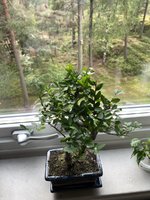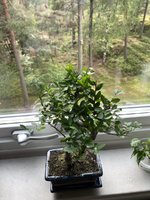Aphystic
Yamadori
Hello, I’ve decided to buy a ts1000 and I’m planning to build a little 60x60cm (24x24”) box with mylar, pc fans and a humidifier alongside the grow light.
Prerequisite: Sweden, usda zone 7a (dark and cold October-mars), no access to garage or other area which is colder than 22c+ except for balcony but out there it could be +8c as well as -20c.
Trees I have: portulacaria afra (jade), carmona (Fukien tea), zelkova (Chinese elm) and sageretia (sweet plum). I also have a cutting which I’m doing a root over rock of a ficus Benjamina but the mother plant have survived without grow light for 10 years so I reckon it should survive as a “bonsai” as well. SEE PICTURES
I’ve read about doing their dormancy in a fridge, put it inside at 8c for 42 days or whatever it is and let it have its dormancy, not sure if that works but would be happy to get answers.
How should I treat my trees during a winter period?
Should I try to make some go dormant in a fridge? Is that crazy?
Keep them all under grow light the entire winter?
I put them outside when temperature allow me during the summer but otherwise they have to be indoors. Please give me all your tips how to treat all these different species that I have
Thank you !
Prerequisite: Sweden, usda zone 7a (dark and cold October-mars), no access to garage or other area which is colder than 22c+ except for balcony but out there it could be +8c as well as -20c.
Trees I have: portulacaria afra (jade), carmona (Fukien tea), zelkova (Chinese elm) and sageretia (sweet plum). I also have a cutting which I’m doing a root over rock of a ficus Benjamina but the mother plant have survived without grow light for 10 years so I reckon it should survive as a “bonsai” as well. SEE PICTURES
I’ve read about doing their dormancy in a fridge, put it inside at 8c for 42 days or whatever it is and let it have its dormancy, not sure if that works but would be happy to get answers.
How should I treat my trees during a winter period?
Should I try to make some go dormant in a fridge? Is that crazy?
Keep them all under grow light the entire winter?
I put them outside when temperature allow me during the summer but otherwise they have to be indoors. Please give me all your tips how to treat all these different species that I have
Thank you !




